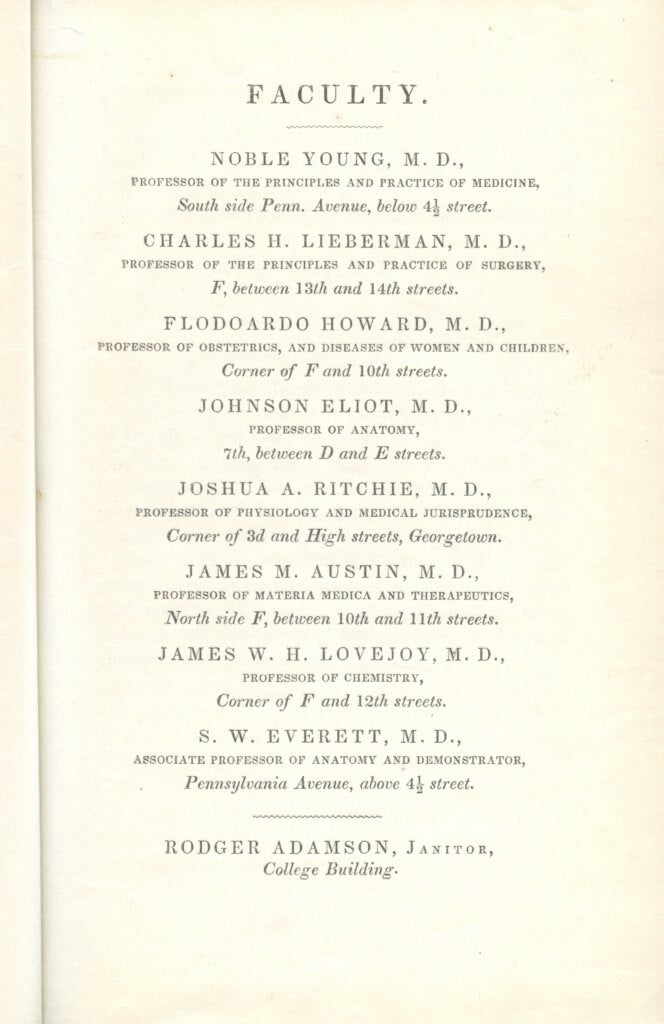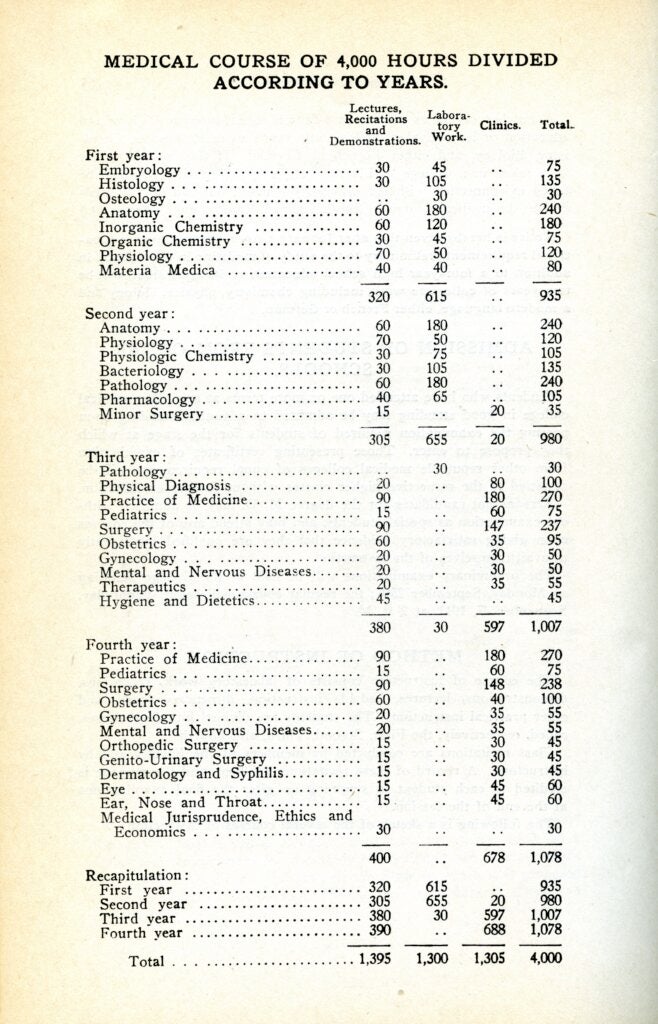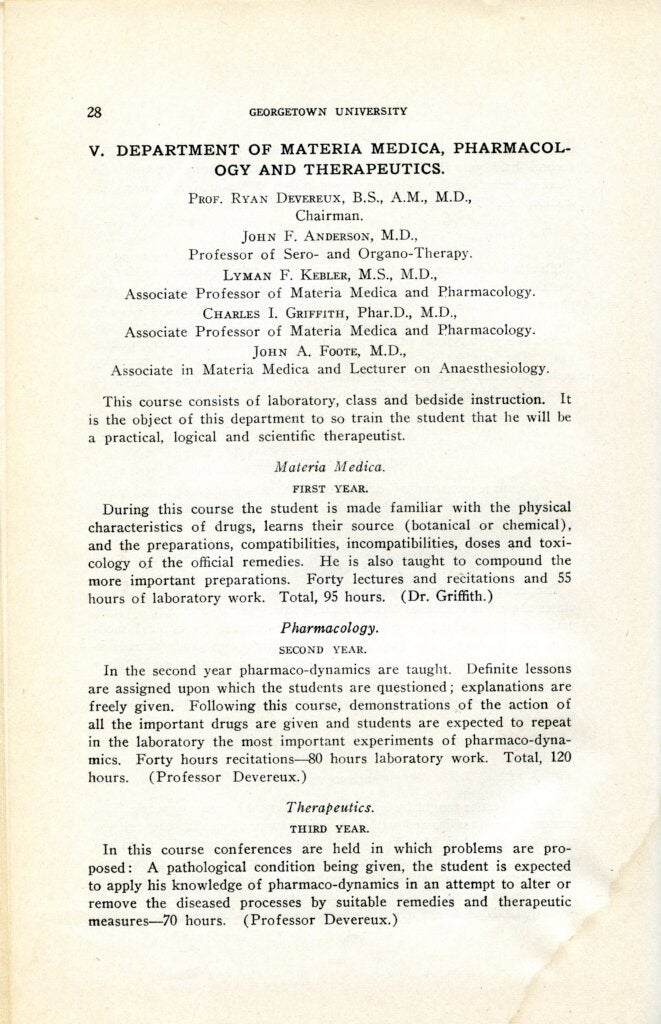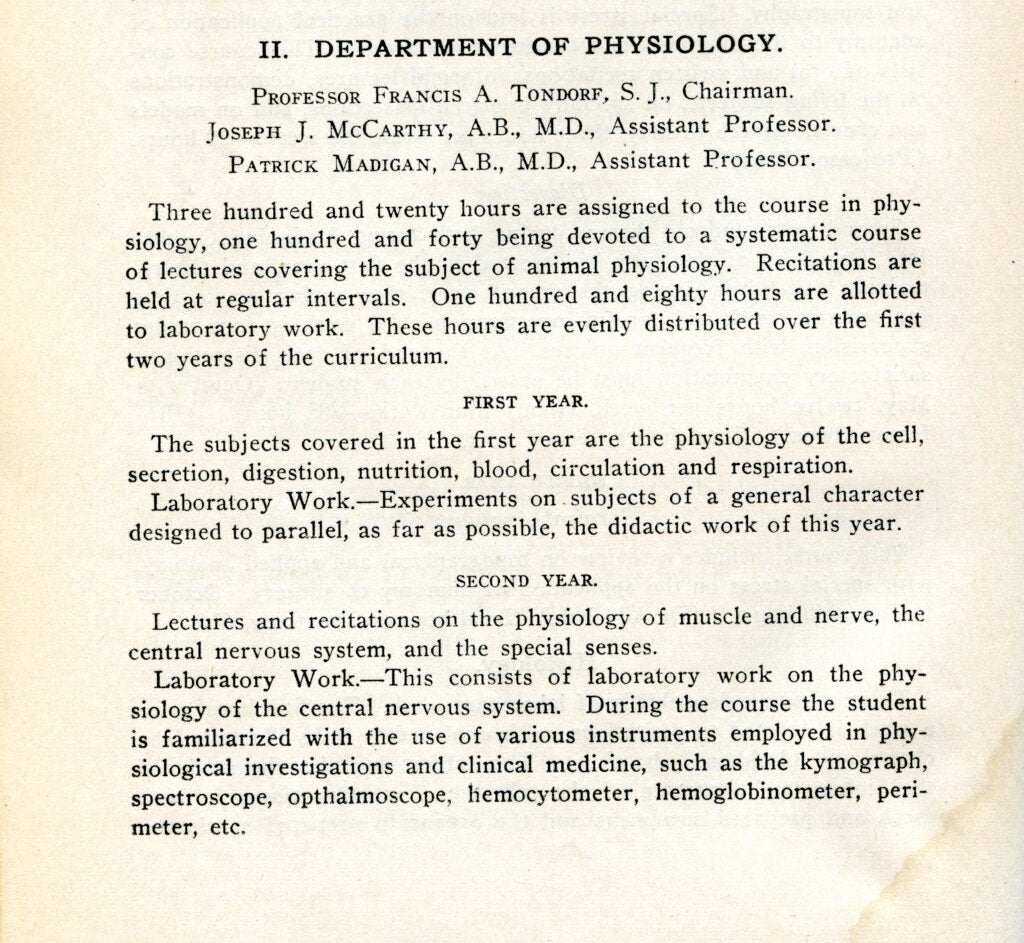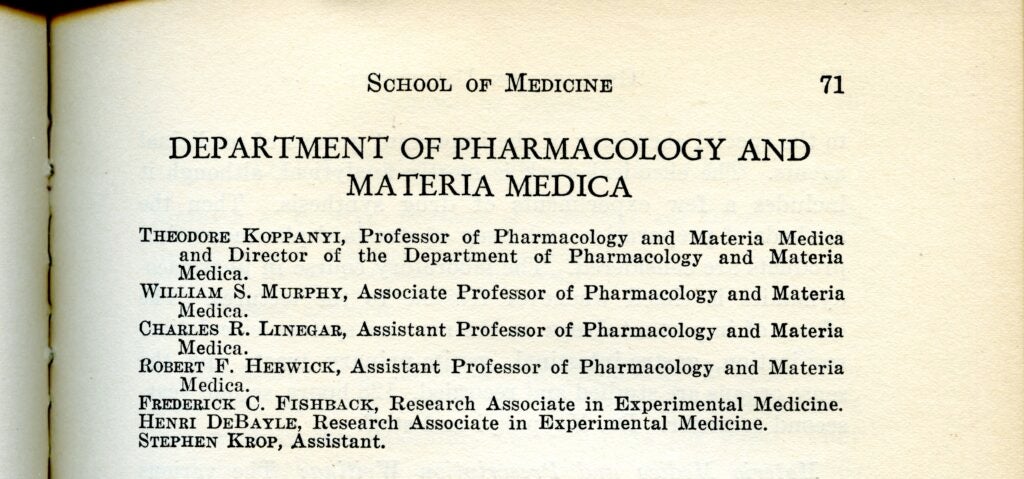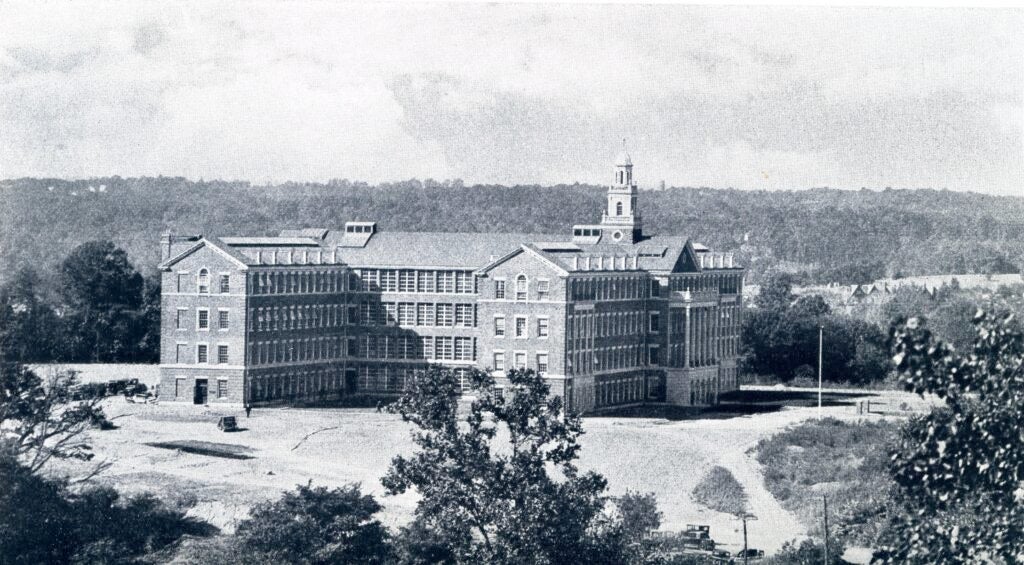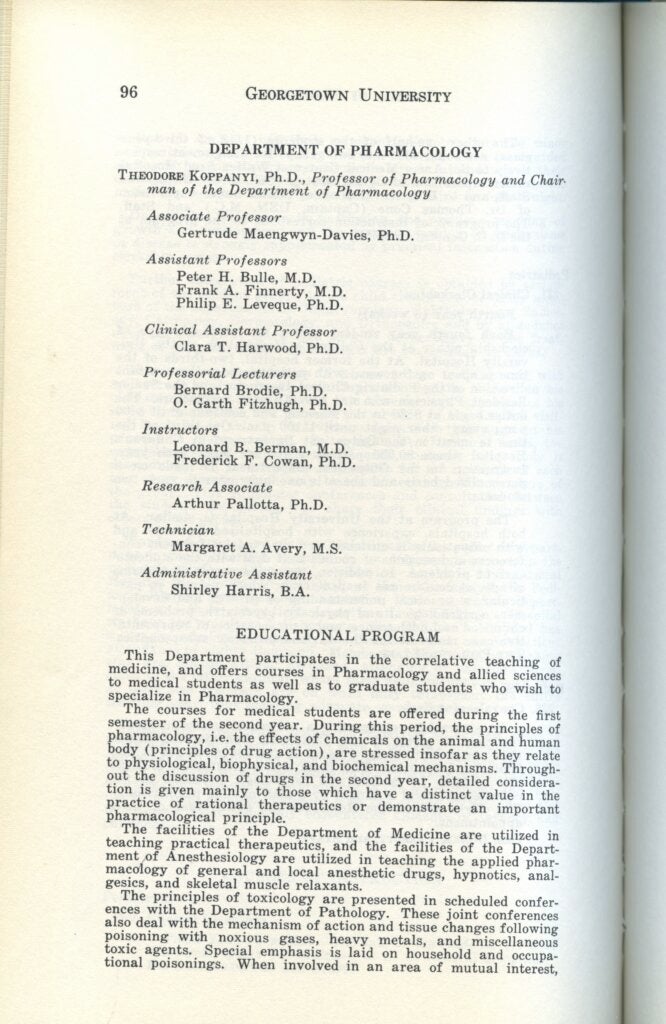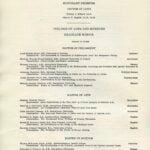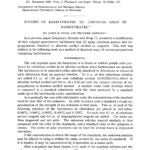Koppanyi retired as Chair in 1967, and Georgetown recognized his 35 years of leadership with an honorary degree, and the department established The Theodore Koppanyi Lectureship in Pharmacology to recognize his contributions to the department and the field.
History
Founding and Early Years
The Department of Pharmacology & Physiology traces its roots back to the founding of Medical Education at Georgetown, with Prof. James M. Austen, M.D., serving as the first Professor of Materia Medica and Therapeutics, and Prof. Joshua A. Ritchie, M.D., serving as the first Professor of Physiology at the University in 1850. At the time, the faculty of the Medical Department (the precursor to the School of Medicine) consisted of eight physicians. During the first 60 years of the medical school, medical education was almost exclusively conducted by part-time clinical faculty.
In the first decade of the 20th century, Abraham Flexner’s groundbreaking assessment of medical schools across the United States yielded recommendations that each school should have a full time faculty to teach future physicians, and that they should engage in scientific methodology and conduct research. While research had yet to take a central role at GUMC, Flexner noted, “a fair equipment for experimental physiology” was present during his visit. A year after the Flexner report was published, Georgetown first taught the discipline of Pharmacology by name in 1911 (view the original course description). At this time, Dr. William Salant was appointed Professor of Experimental Pharmacology, which was the beginning of a research-oriented discipline of Pharmacology at the University.
In 1913, the first eight departments of the School were founded. Among those were the Department of Materia Medica, Pharmacology, and Therapeutics and the Department of Physiology. Dr. John Ryan Deveraux served as the first Chair of the department of Pharmacology from 1912-1919; he was succeeded by Dr. William Barton who served from 1919-1922, and by Dr. Nelson Gapen who served as Chair from 1922 to 1932. Under Gapen’s leadership, the University hired Dr. Theodore Koppanyi in 1930. He was the first member of the department to hold a Ph.D. Only 29 years old at the time of his appointment, had already made impressive contributions to the equally young field of Pharmacology. In a sad turn of events, Dr. Gapen died suddenly in January of 1932. A mere two years into his time at Georgetown, and eleven days after Gapen’s untimely death, Dr. Theodore Koppanyi became Chair of the department.
Theodore Koppanyi and the emergence of neuropharmacology as a research strength
Under Koppanyi research activities of the department began in earnest, and in some respects, Koppanyi’s chairmanship can be thought of as a “second founding” of the department – one that placed great value on research, and one that recognized the synergy between research and excellence in medical education. Koppanyi had broad interests in pharmacology, but had a particular interest in drug action in the nervous system, a theme that continues in our department to this day. During his tenure, he recruited a range of faculty including:
- Dr. Gertrude Maengwyn-Davies, who became the first tenured female faculty member in the department, and served as a Professor of Pharmacology from 1956 to 1976. Maengwyn-Davies was a leader in the field of sympathetic nervous system pharmacology and catecholamines.
- Dr. Seymour Ehrenpreis, who was at the forefront of the burgeoning field of receptor pharmacology, and was one of the first to isolate acetylcholine receptor protein, who served on the faculty from 1961 to 1969.
- Dr. Bernard B. Brodie, a towering figure in pharmacology who brought the discipline to the NIH, and who served as a professional lecturer in the department while running the Laboratory of Chemical Pharmacology at the NIH. He and Koppanyi shared interests in barbiturate pharmacology, and collaborated on several projects.
The Start of the Ph.D. Program
The Ph.D. Program in Pharmacology began in 1934, and we graduated our first Ph.D. student, Dr. James Dille in 1935. Dille, who performed dissertation research under the supervision of Dr. Koppanyi, went on to found the Department of Pharmacology at the University of Washington, and was one of the founding members of the American College of Neuropsychopharmacology. 90 years later, we have trained 180 Ph.D. students in Pharmacology, as well as many additional students in Physiology and in Neuroscience. Our trainees have gone on to become leaders in faculty positions around the country, in industry, and in government. Visit our alumni page to learn more about our former trainees.
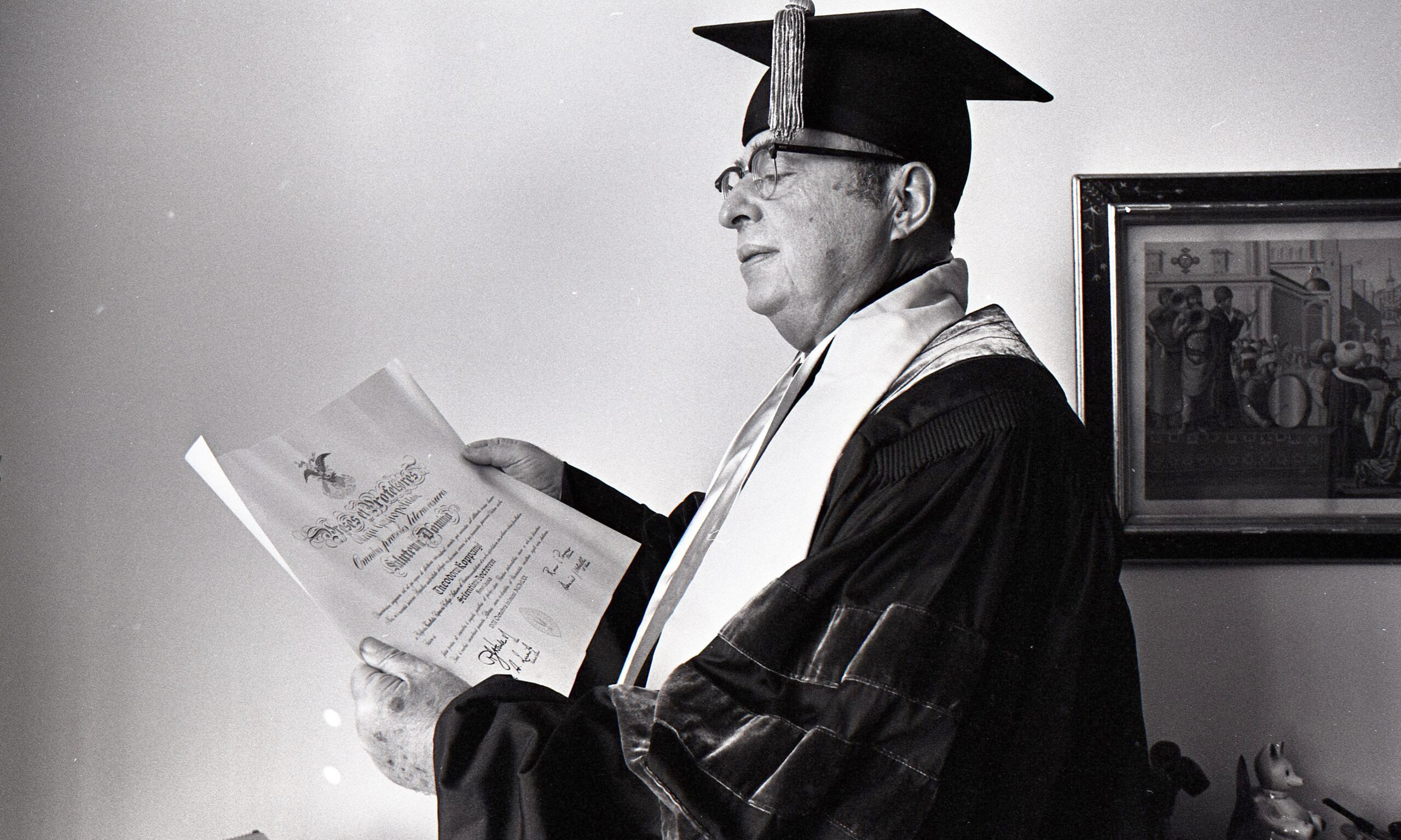
Growth of the Department under Frank Standaert
Upon Koppanyi’s retirement as Chair, the department recruited Dr. Frank Standaert, who served as Chair from 1967 to 1986. Standaert was also the first person to hold the Schering Professorship in Pharmacology, the first endowed professorship in Georgetown’s history.
Standaert, an expert in neuromuscular pharmacology, oversaw a rapid expansion of the Department and recruited many of the faculty who shaped the department into the research and training environment it is today. This included significant new NIH program projects and individual grant funding. Standaert recruited Drs. Kenneth Dretchen and Kenneth Kellar (both of whom later served as Chair), as well as Dr. Karen Gale, Dr. Richard Gills, Dr. Arthur Raines, Dr. William Beaver, and Dr. Sorell Schwartz. While Standaert built research in the Department, he, like his predecessor, also expected excellence in graduate and medical education – an expectation that continues to the present day, and is evident by the number of teaching awards our faculty have received.
During this period, Georgetown formed a partnership with the Italian pharmaceutical company, Fidia. The FIDIA-Georgetown Institute for the Neurosciences was a vibrant contributor to the research activity at GUMC from 1985 through its closure in 1994. The institute was directed by Dr. Erminio Costa, who came to FGIN after almost 20 years as Chief of the Laboratory of Preclinical Pharmacology at NIMH. Dr. Costa built on the strengths of neuropharmacology at Georgetown. Costa, and his deputy, Dr. Alessandro Guidotti, were both professors in the Department of Pharmacology, and helped to recruit Dr. Stefano Vicini, who went on to become a global leader on the physiology and pharmacology of ionotropic glutamate and GABA receptors, and Dr. Jarda Wroblewski, who went on to develop and characterize a wide range of selective metabotropic glutamate receptor agonists and antagonists.
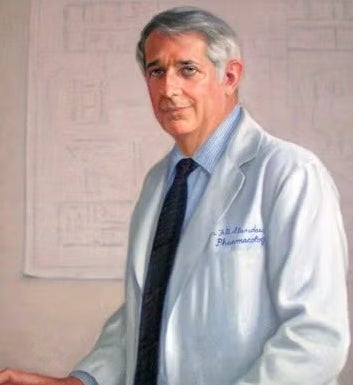
During Standaert’s tenure, the department received its first NIH training grant to support Ph.D. students, and this, along with the rapid expansion of research active faculty, enabled significant growth in the Ph.D. program. During his time as chair, he tripled the number of PhDs awarded; in the first 30 years of the program we trained 15 Ph.D. students. In the next 19, we trained 44. When Standaert left Georgetown for the Medical College of Ohio, Dr. Arthur Raines, a neuropharmacologist, was appointed as Interim Chair.
Standaert’s contributions were recognized by the Department, which established the annual Frank G. Standaert Lectureship in Pharmacology in his honor.
Woosley and Allegra
Dr. Raymond Woosley served as the sixth Chair of the department from 1988 to 2000. Woosley left a lasting impact on the department; he discovered, when consulting with the FDA that the antihistamine terfenadine caused Torsade des Pointes arrhythmia. His collaborative work with Dr. Richard Gillis, an expert on cardiovascular pharmacology and brain control of the peripheral organs, identified the mechanism underlying cardiotoxicity caused by the terfendine, and importantly demonstrated that its active metabolite, fexofenadine, did not (link to the article). Fexofenadine (Allegra) was approved by the FDA as a non-toxic allergy medication, and is a widely utilized over-the-counter antihistamine today. This discovery not only changed the over-the-counter treatment of allergies, but also provided important resources for department growth.
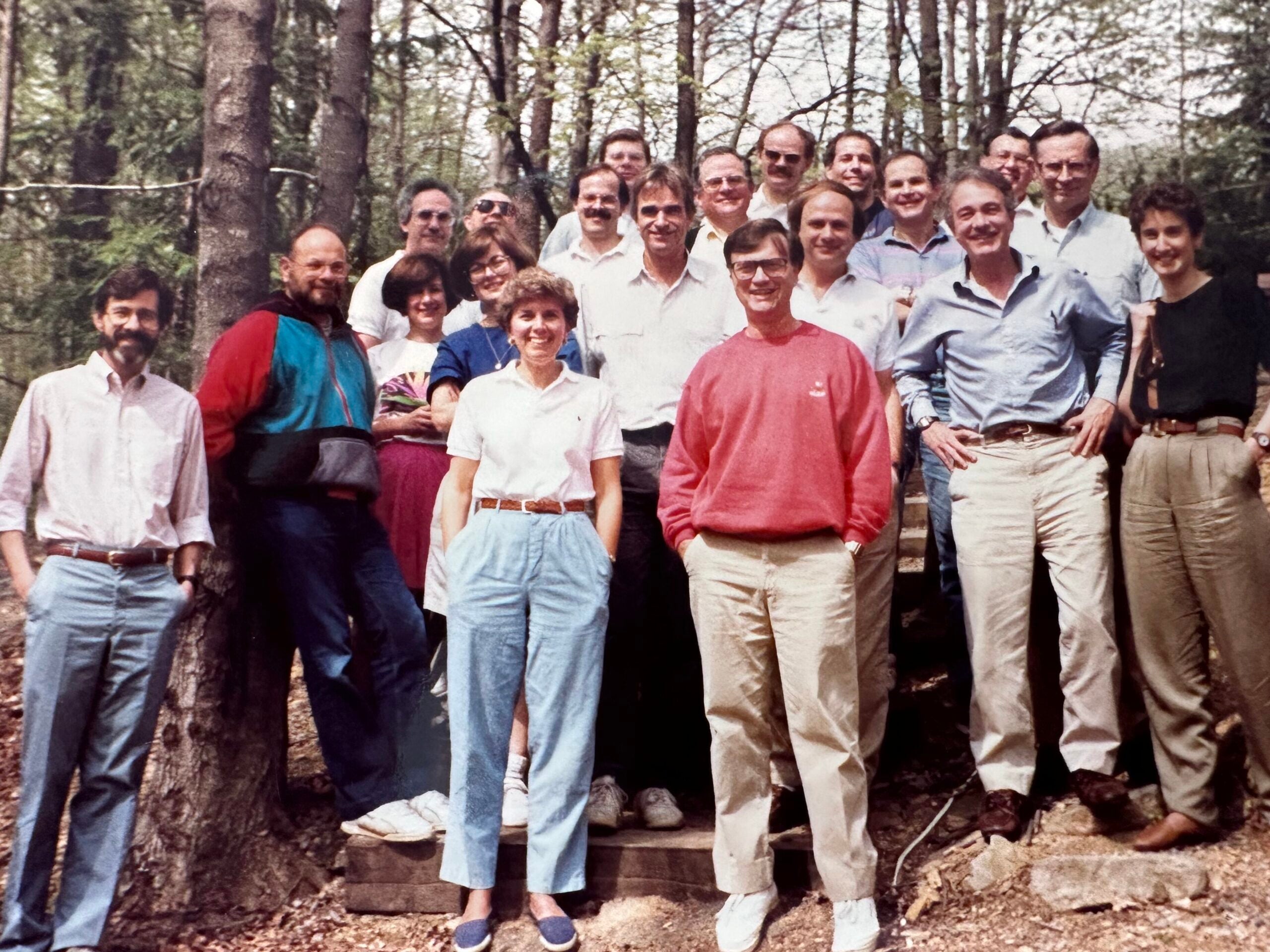
Faculty of the department, circa 1990
During this period, Woosley recruited a range of faculty, including Dr. Barry Wolfe. Wolfe, an expert on beta adrenergic and ionotropic glutmate receptors, went on to direct the Pharmacology Ph.D. program for 30 years – two thirds of our graduates earned their degree under his directorship of the Program. The department named the directorship of the Ph.D. program for Wolfe in 2024.
Woosley also expanded the interests of the department in clinical pharmacology, building on the expertise of Dr. William Beaver, who drafted some of the earliest research guidelines for clinical trials, many which inform the way clinical trials are conducted today. Indeed, many of our faculty, including Beaver, Woosley, Arthur Raines, and Richard Gillis all provided service to the FDA.
This period also saw the expansion of neuroscience research at GUMC. Dr. Karen Gale was the driving force in creating an Interdisciplinary Program in Neuroscience at Georgetown in 1994. Gale, who served as the first director of the Ph.D. program, worked to design a trans-departmental training environment that built bridges between faculty and departments.
The Department in the 21st Century
Following the departure of Dr. Woosley, Dr. Kenneth Dretchen served as Chair from 2000 to 2016. Dretchen established a department endowment based on fexofenadine patent royalties from Dr. Woosley that has supported faculty recruitment for 30 years; at the time of this endowment’s establishment, it was the largest endowment of any pharmacology department in the country.
Dretchen, a former postdoctoral fellow of Frank Standaert’s, returned the focus of the department to Neuropharmacology. He continued to grow research in the department, and recruited many of our current faculty members. In the early 2000s, the department, faced with the retirement of several senior faculty, doubled its research active faculty through rapid recruitment and investment, reinforcing the department’s strengths in signaling and neuropharmacology. During his tenure, the department established The Stephen and Mary Krop Lectureship in Pharmacology, with the generous support of the Krop Family. Stephen Krop earned his MS degree from Georgetown, and worked with Dr. Koppanyi; after earning his Ph.D. in Pharmacology at Cornell, he returned to the DC area and later served as a Professorial Lecturer in the department from 1962 to 1968. In 2005, the department established the Karen Gale Memorial Lectureship for Outstanding Women in Neuroscience, in honor of long-time faculty member, Dr. Karen Gale, who was the founding director of the Interdisciplinary Program in Neuroscience, and an international leader in epilepsy research.
In 2004, the department launched its first M.S. Program, the M.S. in Pharmacology, which serves as a program for trainees to gain research experience prior to PhD training, careers in industry, or medical training.
When the former Department of Physiology dissolved in 2011, several members of that Department of Physiology incorporated into the Department of Pharmacology. In addition to the research that entered the department with these faculty members, the department became the home of two additional MS Programs – the MS in Physiology and the Special MS in Physiology. These programs both prepare post-baccalaureate trainees for medical school; the SMP – founded in 1975 – is the oldest program of its kind in the country.
Dr. Dretchen retired from the University in 2016, but remains an active Emertius faculty member continuing to teach medical students while conducting clinical research as Chief Scientific Officer for Mesa Science Associates.
Dr. Ken Kellar succeeded Dr. Dretchen as Chair in 2016. Kellar, an internationally recognized leader in the field of nicotinic acetylcholine receptor research, continued faculty recruitment – rapidly expanding the department’s focus into systems, circuits, and behavioral pharmacology, which is now a major research strength.
During his tenure, the department and the Ph.D. programs updated their name to reflect the combined disciplines of Pharmacology & Physiology, recognizing the intrinsic link between these two disciplines, and the combined strength of our faculty in both areas of expertise.
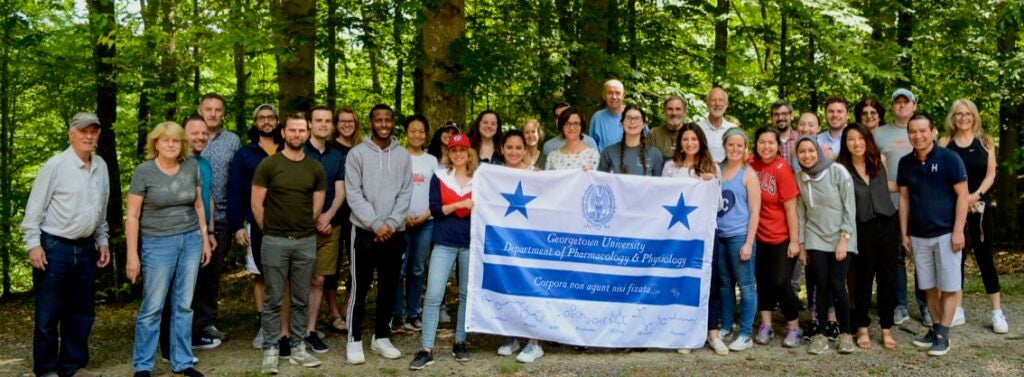
Department of Pharmacology & Physiology retreat, 2019
Under Kellar, Ph.D. training was revitalized. The incoming Ph.D. student class was doubled, which was only possible because of the faculty recruitment that he and Dretchen oversaw. Kellar stepped down as Chair in 2024. He remains a member of the faculty with an active research program and continues to teach medical and graduate students. He was succeeded by Patrick Forcelli, who serves as the current Chair of the department.
Our Mission Today
Our mission today reflects the same goals and values that have guided us for over a century.
- We conduct basic and translational research in the fields of Pharmacology and Physiology, with a particular emphasis on neuropharmacology and neurophysiology.
- Our research aims to improve human health through scientific discovery and translation.
- We train the next generation of scientists and physicians in the disciplines of Pharmacology and Physiology.
- We are guided by the Jesuit concept of cura personalis, which translates as “care of the whole person.” This is realized through individualized attention to the needs of others, distinct respect for unique circumstances and concerns, and an appropriate appreciation for singular gifts and insights.
